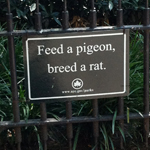
Feb 13, 2013 | by Rabbi Lisa Goldstein, Former Executive Director, Institute for Jewish Spirituality

It is interesting that it took a snowstorm to turn New York City into Jerusalem on a Friday evening.
Like many people who have spent time in Jerusalem, one of things I love the most is the way Friday afternoons come into the Jewish parts of the city. Bit by bit, the stores close and the roads empty out. The sounds of the usual bustle begin to subside and a calm begins to pervade the squares and streets. By the time the sun sets over the plain below, it can feel like the whole city has taken a deep breath and let it out slowly.
Last Friday, with the approach of Snowstorm Nemo, New York City could have been Jerusalem. Sleet was falling in the afternoon and people began leaving, getting to where they would stay for the duration of the storm. Even in Midtown, where our office is, bit by bit, there were fewer cars, less honking and sirens. We closed the office a little early. And by the time the snow began to fall in earnest, later in the evening, as I was on my way to Shabbat dinner, there was a magical hush everywhere. The streets were mostly empty except for people walking, some with their dogs. The glow from the strings of left-over holiday lights caught the softly falling snow. The usually frantic city felt soothed and quiet.
One of the things I love about New York City is the wonderful energy and astonishing abundance of people and buildings and things to do and see and eat and explore. There is usually no stopping it or even any desire to stop it. But on this Erev Shabbat, it seemed like the city shavat vayinafash – stopped and took a breath.
By Shabbat morning the sun was shining and the sky was blue. I made my way to Central Park to explore the snowy woods and to watch the kids (of all ages!) playing in the snow. New York was returning to itself: noisy, colorful, vibrant. Yet, the magic of the snow stayed all through Shabbat. It wasn’t until Sunday that there was more gray slush than pristine fields of snow – just in time for a new workaday beginning to the week.

Oct 16, 2012 | by Rabbi Lisa Goldstein, Former Executive Director, Institute for Jewish Spirituality
 I find it so curious that the Jewish year begins with almost an entire month’s worth of holidays, each one with its own flavor, building upon the one before. We have the sweet awe of Rosh Hashanah, the intense internality of Yom Kippur, the joy and vulnerability of Sukkot, the ecstatic connection to learning on Simchat Torah. It is quite a spiritual journey – and can be exhausting! I hear many people expressing relief that the holidays are “finally” behind us.
I find it so curious that the Jewish year begins with almost an entire month’s worth of holidays, each one with its own flavor, building upon the one before. We have the sweet awe of Rosh Hashanah, the intense internality of Yom Kippur, the joy and vulnerability of Sukkot, the ecstatic connection to learning on Simchat Torah. It is quite a spiritual journey – and can be exhausting! I hear many people expressing relief that the holidays are “finally” behind us.
Which brings us to that seemingly flat time of “after the holidays.” Life is back to normal (whatever that means). We return to the routine and the steadily increasing darkness of the Northern Hemisphere’s approaching winter. Next week we begin the new month of Heshvan, the famous month of no holidays. Sometimes it is known as “Marheshvan,” with a connotation of mar or bitterness. There is no external reason to celebrate; there is nothing obviously interesting or intriguing about it. In some ways, the whole month is the continuation of Shemini Atzeret, the eighth day of Sukkot, which has only one unique feature in the Diaspora: the prayer for rain for the Land of Israel.
And yet, in some ways, these weeks are actually the fruitful time of the year, not the dramatic holiday season just ended. We get to begin living out what we thought, embodying the insights, intentions and hopes for the new year. We get to begin translating the lofty visions into messy, ever-surprising life. It may be dark; it may be rainy; it may be unexciting. But moving from the potential to the actual is filled with power and possibility.
This is precisely where spiritual practice has the most to offer, in offering perspective and wisdom when confronted with difficulty and in guiding us towards more kindness, responsibility, gratitude and integrity. It can even help us find the unexpected shining in ordinary things. There is nothing bitter about that!
Wishing everyone a mindful transition back to the everyday!

Aug 29, 2012 | by Rabbi Lisa Goldstein, Former Executive Director, Institute for Jewish Spirituality

Earlier in the summer, I went to Roosevelt Island. There is a red tram that takes you from the east side of Manhattan, up, over the Queensboro Bridge and the East River and then down to the island. It’s great fun.
I was early to meet my friend and so I waited at the tram depot on the Manhattan side for a while. The little plaza by the station was one of those strange places that for some reason attracts pigeons by the hundreds. My eye was caught by a sign that the New York City Department of Parks and Recreation posted on a fence: “Feed a Pigeon. Breed a Rat.” (And just for the record, I did indeed spy a rat, roughly the size of a pigeon, scurrying beneath the rose bushes.)
The sign reminded me of a classic teaching story that I first heard from Sheila Weinberg. A Native American elder is teaching a group of children, sitting at his feet. He says, “There are two wolves. One is filled with rage and hatred and blame and fear. The other is filled with compassion and forgiveness and peacefulness and faith. These two wolves are fighting. And they are inside me.”
One of the children asks anxiously, “Which wolf will win?”
The elder solemnly replies, “Whichever one I feed.”
In my experience, my more negative thought patterns are very similar to feeding rats and pigeons. I have no desire to feed the rats. But pigeons are innocuous. I find them  dirty and slightly menacing in a weird way, but they’re certainly not on the same level as rats. In the same way, I don’t intend to hold on to things that make me angry, hateful, fearful or judgmental. But I certainly can find myself nursing small grudges or injustices that seem innocuous.
dirty and slightly menacing in a weird way, but they’re certainly not on the same level as rats. In the same way, I don’t intend to hold on to things that make me angry, hateful, fearful or judgmental. But I certainly can find myself nursing small grudges or injustices that seem innocuous.
But in fact, they are not. The New York City Department of Parks and Recreation is exactly right. Feed a pigeon, breed a rat. Cling to that grievance and it inadvertently may shape my thoughts towards something much darker and unwanted.
Of course, there is a place in the world for all kinds of animals, even those we call pests, and anger, fear and hatred are unavoidable – and occasionally even useful – human experiences. It’s a question of appropriateness and discernment. Perhaps the first place we can stop “feeding the pigeons” is with ourselves – by bringing compassion, forgiveness and faith to our mind’s endless capacity for holding on when we might let go.

Aug 8, 2012 | by Rabbi Lisa Goldstein, Former Executive Director, Institute for Jewish Spirituality

Last week was a big week for me. I left my sublet and moved into my very own New York apartment! Even though my new home is not that far from the apartment I was renting, I have to find a new grocery store, a new dry cleaner, a new pharmacy. I also have to figure out how to get to work. I used to live on an express stop on the subway, whereas now I am on the local train. Do I walk down to the express stop? Do I take the local and change trains? Do I ride the local all the way? And most important of all: How long does each of these options take?
As I puzzled over the train schedules, I came across this video from the New York Times: The Subway Shuffle
I had to laugh. Ruefully. There is something undeniably funny about the New Yorkers rushing from platform to platform, trying to shave off a few seconds here and there. (And to be honest, when I lived in California, I used to shift from lane to lane, trying to advance a few yards on the freeway.)
But the truth is that there is a cost to rushing all the time.
 The cost is both inner and outer. The inner cost is that when we hurry, we often fail to notice the truth of experience. Rabbi Kalonymus Kalman Shapira described in his book Conscious Community how important it is to learn how to observe our own inner life because it opens us to being able to sense even more. He said, “Perhaps in your looking you will uncover God’s subtle presence; you may sense God’s holiness.” How do we do that? His answer: “You must clearly, consistently and diligently slow down.” (And he wrote that over 70 years ago!)
The cost is both inner and outer. The inner cost is that when we hurry, we often fail to notice the truth of experience. Rabbi Kalonymus Kalman Shapira described in his book Conscious Community how important it is to learn how to observe our own inner life because it opens us to being able to sense even more. He said, “Perhaps in your looking you will uncover God’s subtle presence; you may sense God’s holiness.” How do we do that? His answer: “You must clearly, consistently and diligently slow down.” (And he wrote that over 70 years ago!)
And the outer cost is that when we hurry, we often fail to notice the truth of other people’s experiences. The famous “Good Samaritan experiment” at Princeton showed that the most important factor in determining whether a seminary student would stop to help someone in need was not how much they thought about helping others or the nature of their religious commitment. Instead the main factor was how late the students thought they were. In fact, only 10% of those who were hurrying paused to help a man slumped on the street, as compared to 63% of those who were not in a hurry.
It is so easy to forget and get swept away by the busyness of our culture. It is so important to keep remembering to take our time.

Jul 5, 2012 | by Rabbi Lisa Goldstein, Former Executive Director, Institute for Jewish Spirituality

It was cool and drizzly when I left my apartment one morning last week, wearing my spring raincoat, but by mid-afternoon, it was sunny and warm. At the end of the day, I walked out of the office, leaving my coat on the rack outside my office door. I rode the crowded subway to my stop, dropped in at the grocery story to pick up a couple of things, and as I started to cross the street to my apartment, all of a sudden, I knew.

The keys to my apartment were not in my bag. They were in the pocket of my raincoat, hanging on the coat rack outside my office door.
I know that moment so well, that mental click from forgetting to remembering. It’s a cold, jarring sensation. It’s the jolt that accompanies waking up in meditation or suddenly knowing the right word for the crossword puzzle. In American Sign Language, it’s the popping up of the index finger in the sign for “understanding.” I think it must be related to the burst of the sephirah chochmah, the flash of creative insight that wasn’t there a moment ago.
The stories that accompany remembering can vary. It can be the exasperation and self-judgment that focuses on the forgetting. (“I am such an idiot! Now I have to get back on the subway, go all the way back to the office and then retrace my steps again!”) Or it can be marveling at the mind’s ability to wake up, even when it used to be asleep. (“How amazing that I remembered before I actually reached into my bag to find my keys!”) It can even be compassion. (“Our poor brains! Think of all the things that bombard us day in and day out! No wonder we forget so much. How else would we survive?”)
For me, the small, inconvenient act of forgetting and remembering spurred me to consider: what else have I forgotten? Have I remembered to be grateful for owning a key and a raincoat, for having the physical strength to get back on the subway, for having an office and a job, for walking through the early evening light in New York City with the thousands of other people, each with their own hopes and disappointments and stories?
So much of spiritual practice is about remembering to remember.










 The cost is both inner and outer. The inner cost is that when we hurry, we often fail to notice the truth of experience.
The cost is both inner and outer. The inner cost is that when we hurry, we often fail to notice the truth of experience. 

